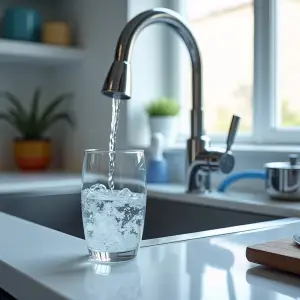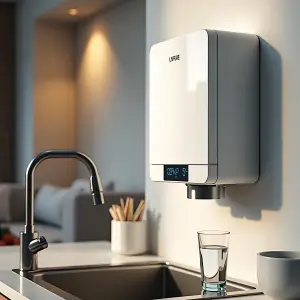Reading time: approximately 9 minutes
I. Introduction
Access to clean drinking water is a fundamental human right, yet millions in India face the daily challenge of water contamination. A significant portion of households rely on water purifiers for safe drinking water, highlighting the critical need for reliable and effective purification solutions. Kent, a prominent name in the Indian water purification market, offers a wide range of purifiers designed to meet diverse needs and budgets. This comprehensive guide will delve into the world of Kent water purifiers, exploring their technology, various models, maintenance requirements, and addressing frequently asked questions. We will cover everything from the basics of water purification technologies to choosing the right Kent purifier for your specific needs, providing you with all the information necessary to make an informed decision. Kent offers a variety of purification systems, including Reverse Osmosis (RO), Ultraviolet (UV), and Ultrafiltration (UF) technologies, catering to different water quality conditions and household sizes.
II. Understanding Water Purification Technologies – A Kent Focus
Water purification is crucial for removing harmful contaminants that can cause various health issues. These contaminants can be categorized as physical (sediments, rust), chemical (pesticides, heavy metals), and biological (bacteria, viruses). Kent employs several advanced technologies to tackle these contaminants:
-
Reverse Osmosis (RO): RO technology uses a semi-permeable membrane to filter out dissolved impurities, including salts, minerals, and other contaminants. Kent RO purifiers are known for their double purification process, enhancing the effectiveness of the filtration. Regular maintenance, including timely filter changes, is crucial for optimal performance and to prevent membrane scaling and fouling. Neglecting Kent RO service can significantly reduce the efficiency of the purifier.
-
Ultraviolet (UV) Technology: UV purification uses ultraviolet light to kill bacteria and viruses by damaging their DNA. Kent UV purifiers are often used in conjunction with other technologies like RO or UF to provide a multi-stage purification process. UV is particularly useful for treating water that is already relatively clean but may still contain harmful microorganisms.
-
Ultrafiltration (UF) and TDS Control: UF filters remove larger particles like bacteria and suspended solids. TDS (Total Dissolved Solids) controllers regulate the mineral content in the purified water, ensuring a balanced taste and preventing excessive mineral depletion. Kent incorporates these technologies in various models to optimize purification based on the specific water source and user preferences.
| Technology |
How it Works |
Benefits |
Drawbacks |
Kent Applications |
| RO |
Semi-permeable membrane filters dissolved impurities |
Removes a wide range of contaminants |
Can be slow, wastes water, removes beneficial minerals |
Kent Grand, Kent Pride Plus, many others |
| UV |
Ultraviolet light kills microorganisms |
Effective against bacteria and viruses |
Ineffective against dissolved chemicals |
Often combined with RO or UF in Kent models |
| UF |
Membrane filters larger particles |
Removes suspended solids and bacteria |
Less effective than RO for dissolved impurities |
Used in conjunction with other technologies |
| TDS Control |
Regulates mineral content |
Maintains balanced taste, prevents mineral depletion |
Requires regular monitoring and adjustment |
Several Kent models offer this feature |
III. Exploring the Kent Water Purifier Range
Kent offers a diverse range of water purifiers catering to various needs and budgets. Here are some popular models:
-
Kent Perk: A compact and affordable model, ideal for small families or individuals with relatively clean water sources. It typically features UV and UF purification stages. Price range varies depending on retailer and promotions. Pros: affordability, compact size; Cons: limited purification stages, may not be suitable for heavily contaminated water.
-
Kent Pride: This model usually incorporates RO+UV purification, offering a higher level of purification than the Perk. It is suitable for medium-sized families and a wider range of water sources. Price range is higher than the Perk. Pros: effective purification, relatively affordable; Cons: might still not be suitable for extremely contaminated water. Check out the product on Amazon
-
Kent Grand: Known for its advanced Save Water Technology, the Grand aims to minimize water wastage during the purification process. It often includes RO+UV+UF purification stages. Price range is higher than the Pride. Pros: advanced technology, water-saving features; Cons: higher price point. Check out the product on Amazon
-
Kent Smart: This model incorporates smart features like an interactive touchscreen display for real-time monitoring of purity, performance, and service history. It often features advanced purification technologies [4]. Price range is typically at the higher end of Kent’s offerings. Pros: advanced features, ease of monitoring; Cons: higher price.
-
Kent Sapphire: A model often incorporating multiple purification stages (RO, UV, UF) and designed for efficient and effective purification. Price range is typically in the mid to high range. Pros: reliable purification; Cons: price point might be higher than basic models. Check out the product on Amazon
| Model |
Capacity (l/hr) |
Purification Stages |
TDS Adjustment |
Approximate Price Range (INR) |
| Kent Perk |
Varies |
UV/UF |
No |
₹5,000 – ₹10,000 |
| Kent Pride |
Varies |
RO+UV |
Often |
₹10,000 – ₹20,000 |
| Kent Grand |
Varies |
RO+UV+UF |
Often |
₹20,000 – ₹35,000 |
| Kent Smart |
Varies |
RO+UV+UF+Smart features |
Often |
₹30,000 – ₹50,000+ |
| Kent Sapphire |
Varies |
RO+UV+UF |
Often |
₹15,000 – ₹30,000 |
(Note: Prices are approximate and can vary based on retailer, promotions, and specific features. Always check with the retailer for the most up-to-date pricing.)
Many newer Kent models offer smart features, such as real-time monitoring, alerts for filter changes, and remote control via mobile apps. These features enhance convenience and ensure optimal purifier performance.
IV. Kent Water Purifier Price Guide
The price of a Kent water purifier is influenced by several factors: the purification technology used (RO, UV, UF), the purifier’s capacity (liters per hour), additional features (TDS control, smart features), and the specific model. Basic UV or UF models are generally more affordable than advanced RO systems with multiple purification stages and smart features. The initial purchase price is only one aspect of the overall cost; long-term maintenance, including filter replacements and potential service calls, should also be considered. Kent purifiers can be purchased online through major e-commerce platforms like
Amazon, check my affiliate link for discounts.
V. Kent RO Service & Maintenance
Regular maintenance is vital for extending the lifespan and ensuring the optimal performance of Kent RO systems. A typical maintenance schedule includes pre-filter cleaning or replacement every 3-6 months, RO membrane replacement every 1-2 years, and UV lamp replacement every year. While some basic maintenance tasks, like pre-filter cleaning, can be done at home, more complex tasks like membrane replacement are best left to authorized Kent service centers. Finding authorized service centers is usually easy through the Kent website or by contacting their customer support. Common issues like low water flow, TDS fluctuations, or leaks can often be resolved through routine maintenance or by contacting a service technician. Using genuine Kent spare parts is crucial for maintaining the purifier’s warranty and ensuring its long-term performance. Check out our Blog on
Water Purifier Maintenance: A Complete Guide to Clean, Safe Drinking Water
VI. The Qnet & Kent Connection
Qnet, a direct selling company, markets Kent water purifiers in some regions. This partnership doesn’t mean Kent purifiers are exclusively available through
Qnet. they are also widely available through standard retail channels. The partnership simply represents an additional distribution channel for Kent products. Any concerns regarding Qnet’s business model should be addressed separately from the quality and performance of Kent’s water purification technology itself.
VII. Kent Water Purifier Review – A Summarized Look
Kent water purifiers generally receive positive feedback for the taste of purified water, the effectiveness of purification, and the build quality. However, some criticisms include occasional service availability issues, the cost of filter replacements, and occasional reports of reliability problems. User reviews on various online platforms should be consulted for a balanced perspective. What sets Kent apart is its wide range of models catering to diverse needs and budgets, coupled with its established presence and reputation in the Indian market.
VIII. Choosing the Right Kent Purifier for Your Needs
Selecting the right Kent purifier depends on several factors:
-
Water Source: If you have heavily contaminated water (high TDS, presence of heavy metals), an RO system is recommended. For relatively clean water, a UV or UF system might suffice.
-
Daily Water Consumption: Choose a model with a capacity that meets your household’s daily water needs.
-
Budget: Kent offers a wide range of models at different price points, allowing you to find a purifier that fits your budget.
Refer back to Section III for detailed model descriptions to help you make an informed decision.
IX. Conclusion
Kent water purifiers provide a reliable and efficient solution for accessing clean and safe drinking water. Choosing the right model depends on your water source, consumption needs, and budget. Remember to factor in the cost of regular maintenance and filter replacements for long-term cost-effectiveness. By understanding the different technologies and models offered by Kent, you can make an informed decision that ensures the health and well-being of your family. Visit
Kent’s official website for more information and to explore their complete range of products
or Check out our blog post on Kent, Aquaguard , Gravity filters and Livpure Or, still unsure of filter system right you, check out our blogs on A Comprehensive Guide to Water Purification
FAQ
-
Q: How often should I replace the filters in my Kent purifier?A: The frequency of filter replacement varies depending on the model and the quality of your water source. Refer to your purifier’s manual for specific recommendations. Generally, pre-filters are replaced more frequently than RO membranes or UV lamps.
-
Q: Where can I find authorized Kent service centers?A: You can usually find authorized service centers through the Kent website or by contacting their customer support.
-
Q: What is the difference between RO, UV, and UF purification technologies?A: Refer to Section II of this guide for a detailed explanation of these technologies and their respective benefits and drawbacks.
-
Q: How much does Kent RO service typically cost?A: The cost of Kent RO service varies depending on the service package and the specific repairs or replacements required. Contact a local authorized service center for a quote.
-
Q: Are Kent purifiers only available through Qnet?A: No, Kent purifiers are widely available through various retail channels, including online retailers and authorized dealers. Qnet is just one distribution channel for Kent products.



